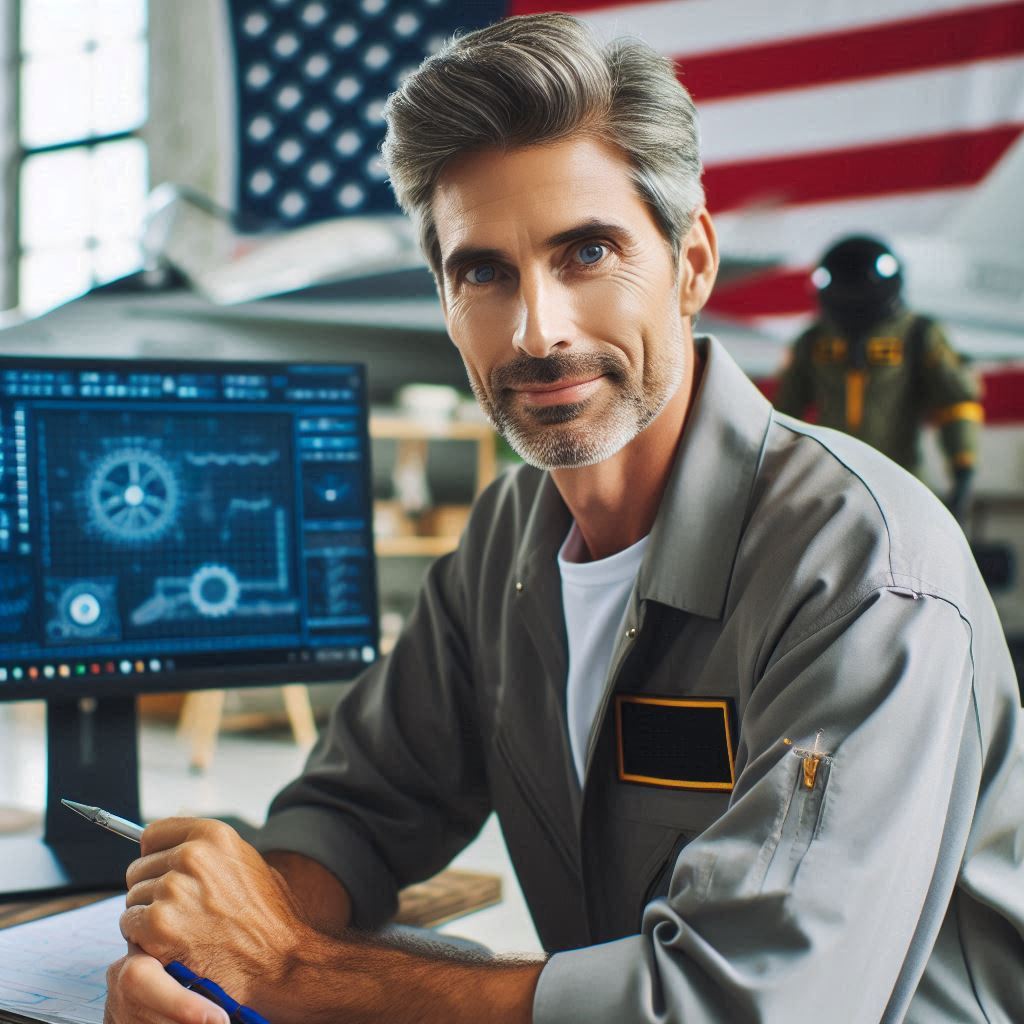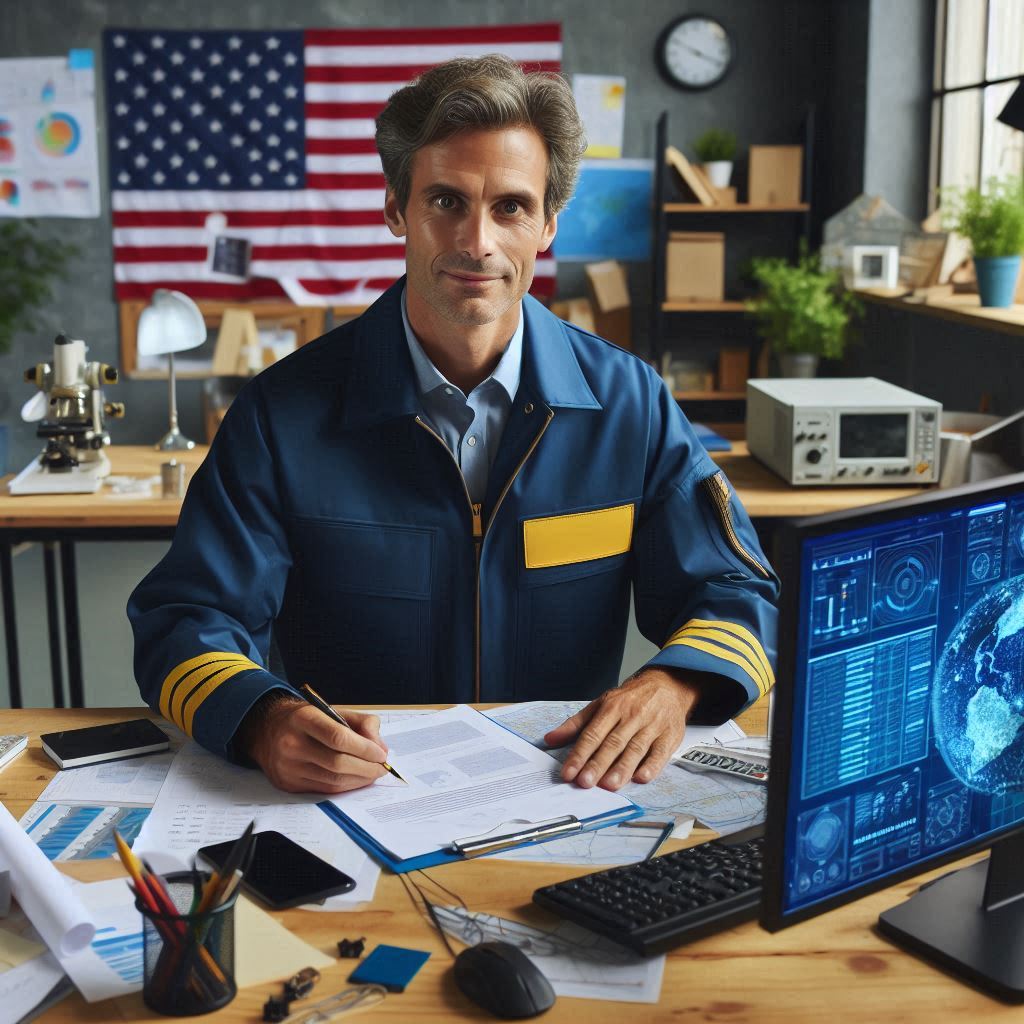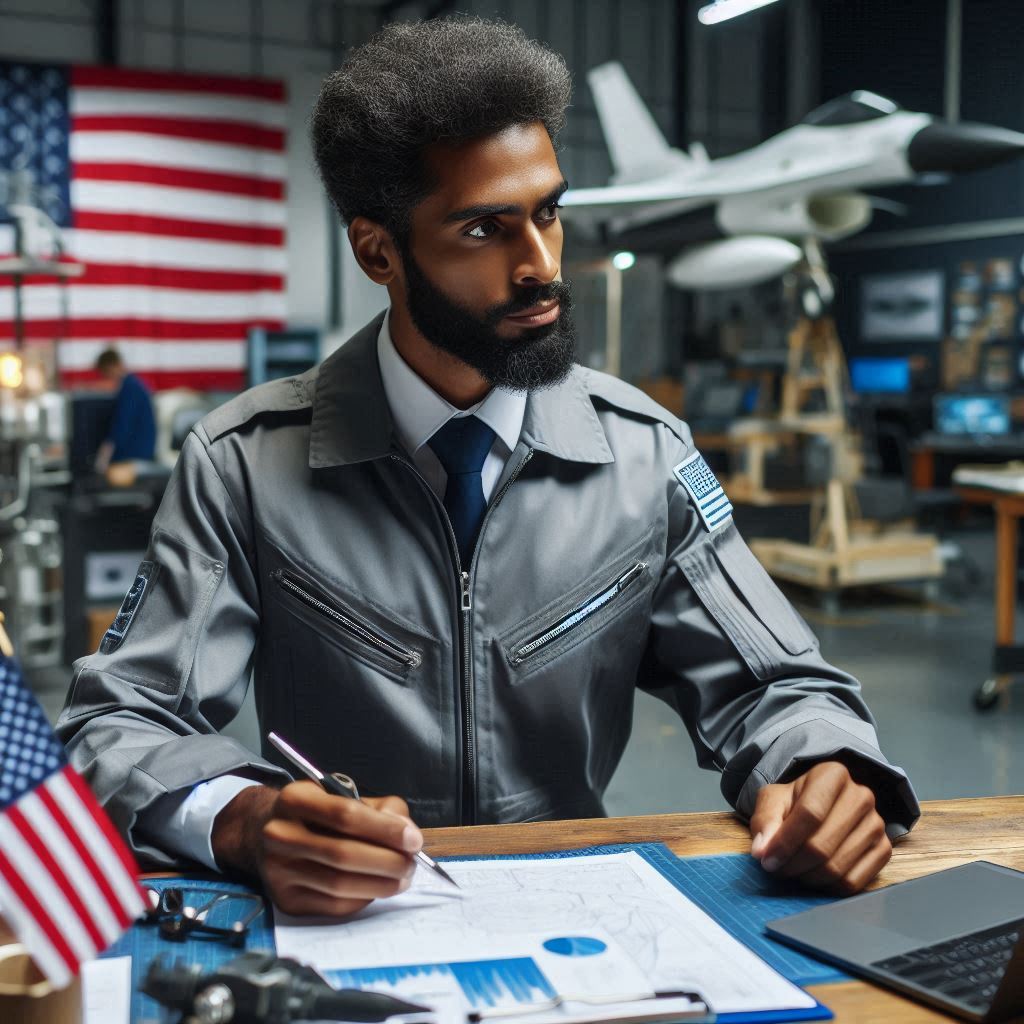Introduction
Aerospace engineering is crucial in today’s world, driving advancements in aviation and space exploration.
The demand for aerospace professionals continues to rise as technology evolves and global connectivity increases.
This blog post provides an overview of the degree requirements for aspiring aerospace engineers, outlining the essential educational paths and skills needed.
Soft skills, such as problem-solving, teamwork, and communication, are equally important.
Aerospace engineers often work in multidisciplinary teams, requiring collaboration and effective communication to achieve project goals.
Pursuing an aerospace engineering degree equips students with the knowledge and skills to design and develop advanced aerospace systems.
It prepares them to tackle complex engineering challenges and contribute to cutting-edge innovations.
Whether you’re passionate about aviation, space exploration, or both, meeting these degree requirements is the first step towards a rewarding career in aerospace engineering.
Aspiring aerospace engineers should embrace the educational journey and take advantage of every opportunity to learn and grow.
By building a solid academic foundation, gaining practical experience, and developing essential soft skills.
You will be well-prepared to succeed in this exciting and ever-evolving field.
The future of aerospace engineering holds endless possibilities, and with the right education and dedication, you can be at the forefront of these advancements.
Overview of Aerospace Engineering
Aerospace Engineering and Its Significance in the Field of Aeronautics and Astronautics
Aerospace engineering focuses on the design, development, and testing of aircraft, spacecraft, and related systems.
This engineering discipline is crucial for advancing technologies in aeronautics and astronautics.
Aerospace engineers contribute to the creation of safer, more efficient, and innovative flying machines.
Aerospace engineering encompasses two main branches: aeronautical engineering and astronautical engineering.
Aeronautical engineering deals with aircraft operating within Earth’s atmosphere.
Astronautical engineering focuses on spacecraft and systems used beyond Earth’s atmosphere.
Both branches play vital roles in exploring and utilizing air and space.
Aerospace engineering is significant because it pushes the boundaries of human capabilities.
Engineers in this field develop technologies that enhance our understanding of the universe.
Their work supports the advancement of commercial aviation, space exploration, and national defense.
The Broad Range of Applications of Aerospace Engineering, Including Aircraft, Spacecraft, and Missiles
Aerospace engineering has a broad range of applications in various industries.
One of the primary applications is in aircraft design and development.
Engineers design commercial planes, military jets, helicopters, and unmanned aerial vehicles (UAVs).
Their innovations improve flight safety, efficiency, and environmental sustainability.
In addition to aircraft, aerospace engineering is essential for spacecraft development.
Engineers design and build rockets, satellites, space probes, and space stations.
Their work enables space exploration, satellite communications, and scientific research.
The development of reusable rockets has revolutionized space travel, making it more accessible and cost-effective.
The automotive industry benefits from aerospace engineering as well.
Engineers apply aerospace principles to develop more efficient and aerodynamically optimized vehicles.
Technologies initially developed for aircraft and spacecraft find applications in improving automotive design and performance.
Furthermore, aerospace engineering contributes to the development of advanced propulsion systems.
Engineers design engines and propulsion technologies that improve fuel efficiency and reduce emissions.
Innovations in propulsion systems support sustainable aviation and space travel.
Aerospace engineering is a vital field that drives innovation in aeronautics and astronautics.
Aerospace engineers design, develop, and test aircraft, spacecraft, and missiles, contributing to numerous industries.
Their work enhances flight safety, space exploration, national defense, and environmental monitoring.
The broad range of applications of aerospace engineering demonstrates its significance.
From commercial aviation to space exploration and missile technology, aerospace engineers push the boundaries of what is possible.
Their contributions lead to technological advancements that benefit society and expand our understanding of the universe.
By understanding aerospace engineering degree requirements and the field’s significance, aspiring engineers can prepare for a rewarding career.
The impact of aerospace engineering will continue to shape the future of air and space travel, national security, and technological innovation.
Educational Background Required
Academic Qualifications Needed to Pursue a Degree in Aerospace Engineering
Pursuing a degree in aerospace engineering requires a strong academic foundation, especially in mathematics and science.
Prospective students need to meet specific qualifications to gain admission into reputable aerospace engineering programs.
Most programs require a high school diploma or equivalent, with a strong emphasis on STEM subjects.
Key Subjects: Mathematics
Mathematics is a critical subject for aerospace engineering.
It provides the necessary tools for problem-solving and analysis in this field.
Students must excel in subjects like calculus, algebra, and trigonometry.
These areas of mathematics are fundamental for understanding the complex calculations involved in aerodynamics, propulsion, and structural analysis.
Calculus, in particular, is essential for modeling and analyzing systems in aerospace engineering.
It helps engineers understand changes in variables, which is crucial for designing efficient and safe aircraft and spacecraft.
Algebra and trigonometry are also vital for understanding the relationships between different physical quantities and for performing necessary calculations.
Key Subjects: Physics
Physics is another core subject that underpins the principles of aerospace engineering.
Understanding the laws of motion, forces, and energy is crucial for designing and analyzing aircraft and spacecraft.
High school physics courses covering mechanics, thermodynamics, and electromagnetism provide a strong foundation for future studies.
In aerospace engineering, physics helps explain how objects move through air and space.
It is essential for understanding aerodynamics, which involves the behavior of air as it interacts with solid objects like wings and fuselages.
Thermodynamics, another critical area, deals with the principles of heat and energy transfer, which are crucial for propulsion systems.
Key Subjects: Chemistry
Chemistry, while less emphasized than mathematics and physics, is still an important subject for aerospace engineering students.
A solid understanding of chemistry is necessary for studying materials science, which is vital for developing new materials used in aircraft and spacecraft construction.
Chemistry courses provide knowledge about chemical reactions, properties of materials, and the behavior of different substances under various conditions.
This knowledge is crucial for selecting materials that can withstand extreme temperatures and stresses in aerospace applications.
Additionally, chemistry plays a role in understanding fuel composition and combustion processes, which are critical for propulsion systems.
Essentially, pursuing a degree in aerospace engineering requires a strong academic background in mathematics, physics, and chemistry.
These subjects provide the foundational knowledge needed to understand and apply engineering principles in the aerospace field.
Prospective students should focus on excelling in these areas during their high school education to prepare for the rigorous coursework in aerospace engineering programs.
By mastering these subjects, students will be well-equipped to tackle the challenges and innovations in the dynamic field of aerospace engineering.
Bachelor’s Degree Requirements
The typical coursework for a bachelor’s degree in aerospace engineering
A bachelor’s degree in aerospace engineering offers a comprehensive foundation in various technical subjects.
Core coursework includes mathematics, physics, and chemistry.
These subjects form the basis for understanding more complex engineering concepts.
Students begin with fundamental courses in calculus, differential equations, and linear algebra.
These mathematical tools are essential for solving engineering problems.
Physics courses cover mechanics, thermodynamics, and electromagnetism.
These principles underpin the behavior of aerospace systems.
Chemistry provides an understanding of material properties and reactions.
This knowledge is vital for selecting appropriate materials for aircraft and spacecraft.
Engineering-specific courses start with an introduction to aerospace engineering.
This course provides an overview of the field and its challenges.
Aerodynamics
Aerodynamics courses teach students about airflow around objects.
Students learn how to analyze and design airfoils and wings.
They study the principles of lift, drag, and thrust.
These courses often include lab work with wind tunnels and computational fluid dynamics software.
Propulsion Systems
Courses on propulsion systems focus on the mechanics of engines and motors.
Students learn about jet engines, rocket propulsion, and combustion processes.
They study how to maximize efficiency and performance while minimizing environmental impact.
Structures and Materials
In structures and materials courses, students learn to design and analyze aircraft structures.
They study the properties of metals, composites, and other materials.
Courses cover stress analysis, structural dynamics, and fatigue testing.
This knowledge ensures that aerospace structures are strong and lightweight.
Avionics
Avionics courses cover the electronic systems used in aircraft.
Students learn about navigation, communication, and control systems.
They study radar, GPS, and flight control systems.
These courses emphasize reliability and integration of complex electronic systems.
Systems Engineering
Systems engineering courses teach students to manage complex projects.
They learn to integrate various subsystems into a cohesive whole.
These courses focus on project management, systems design, and lifecycle analysis.
Capstone Design Projects
Aerospace engineering programs often culminate in a capstone design project.
Students work in teams to design, build, and test an aerospace system.
This project integrates knowledge from all previous coursework.
Importance of practical hands-on experience through internships or co-op programs
Practical hands-on experience is crucial for aspiring aerospace engineers.
Internships and co-op programs provide real-world experience.
Students apply theoretical knowledge to practical problems in industry settings.
Gaining Industry Insights
Internships offer insights into industry practices and standards.
Students learn about the latest technologies and methodologies.
They gain exposure to the work environment and company culture.
Building Professional Networks
Internships help students build professional networks.
They connect with industry professionals who can provide guidance and mentorship.
Networking can lead to job opportunities after graduation.
Enhancing Problem-Solving Skills
Hands-on experience enhances problem-solving skills.
Students tackle real-world challenges and develop practical solutions.
This experience builds confidence and competence.
Transform Your Career Today
Unlock a personalized career strategy that drives real results. Get tailored advice and a roadmap designed just for you.
Start NowImproving Job Prospects
Employers value candidates with practical experience.
Internships and co-op programs make graduates more competitive in the job market.
Practical experience demonstrates a candidate’s ability to contribute effectively from day one.
A bachelor’s degree in aerospace engineering requires a mix of coursework and practical experience.
Core courses cover essential principles in mathematics, physics, and chemistry.
Specialized courses in aerodynamics, propulsion, structures, and avionics provide in-depth knowledge.
Practical hands-on experience through internships or co-op programs is invaluable.
It enhances learning, builds professional networks, and improves job prospects.
This combination of theoretical and practical training prepares students for successful careers in aerospace engineering.
Read: Iconic US Buildings and the Architects Behind Them.
Master’s Degree Requirements
The Advanced Coursework and Research Opportunities Available for Students Pursuing a Master’s Degree in Aerospace Engineering
Pursuing a master‘s degree in aerospace engineering offers students advanced coursework and research opportunities.
Graduate programs provide a deeper understanding of complex aerospace concepts.
These programs include advanced classes in fluid dynamics, thermodynamics, and control systems.
Students learn to apply these principles to real-world aerospace challenges.
Research opportunities are a significant component of a master‘s degree.
Students engage in cutting-edge research projects under the guidance of experienced faculty.
These projects allow students to explore innovative solutions to aerospace engineering problems.
They often involve collaboration with industry partners and government agencies.
Graduate students have access to state-of-the-art laboratories and facilities.
These resources enable hands-on experimentation and testing of aerospace designs.
Participation in research enhances problem-solving skills and technical expertise.
It also prepares students for careers in academia, industry, or government research.
The Option to Specialize in Areas Such as Aerodynamics, Propulsion, or Structures
Master‘s programs in aerospace engineering offer the option to specialize in specific areas.
Specialization allows students to focus on their interests and career goals.
One popular specialization is aerodynamics.
Students in this area study the behavior of air around objects, such as aircraft and spacecraft.
They learn to design more efficient and stable flying machines.
Another key area of specialization is propulsion.
This field focuses on the systems that move aircraft and spacecraft.
This specialization is crucial for ensuring the safety and reliability of aerospace vehicles.
In addition to these core specializations, some programs offer other focus areas.
These may include avionics, space systems, and aerospace materials.
Each specialization provides targeted knowledge and skills that are highly valued in the aerospace industry.
Pursuing a master‘s degree in aerospace engineering offers students advanced coursework and research opportunities.
These programs provide a deeper understanding of complex aerospace concepts and principles.
Graduate students engage in cutting-edge research projects, enhancing their problem-solving skills and technical expertise.
Specialization options allow students to focus on their interests and career goals.
Areas such as aerodynamics, propulsion, and structures are crucial for the development of efficient, safe, and innovative aerospace vehicles.
Other focus areas, such as avionics and space systems, offer additional opportunities for specialized knowledge.
By pursuing a master‘s degree in aerospace engineering and specializing in a targeted area, students can prepare for rewarding careers.
They will be equipped with advanced skills and knowledge that are highly valued in the aerospace industry.
Their contributions will drive innovation and advancements in aeronautics and astronautics, shaping the future of flight and space exploration.
Read: Economic Indicators and Their Influence on US Architects

Doctoral Degree Requirements
The rigorous research component involved in obtaining a Ph.D. in aerospace engineering
Pursuing a Ph.D. in aerospace engineering involves a rigorous research component.
This advanced degree focuses on original research that contributes to the field.
Doctoral candidates undertake extensive studies to address complex aerospace challenges.
Foundational Coursework and Research Preparation
Before diving into research, Ph.D. students complete foundational coursework.
These courses cover advanced topics in aerospace engineering and related fields.
This academic preparation equips students with the theoretical knowledge needed for research.
Identifying Research Topics
Ph.D. students work closely with faculty advisors to identify research topics.
These topics often address current issues or gaps in aerospace engineering knowledge.
Selecting a meaningful research topic is crucial for making significant contributions to the field.
Conducting Original Research
Doctoral candidates engage in original research throughout their Ph.D. programs.
This research involves designing experiments, collecting data, and analyzing results.
The goal is to develop new insights, theories, or technologies in aerospace engineering.
Publishing and Disseminating Research Findings
Ph.D. students are expected to publish their research findings in academic journals.
They also present their work at conferences and seminars.
Sharing research results with the broader scientific community is a key aspect of the doctoral journey.
Dissertation and Defense
The culmination of a Ph.D. program is the dissertation.
This comprehensive document details the research process, findings, and contributions.
Students must defend their dissertation before a committee of experts.
Successful defense of the dissertation is the final step in earning a Ph.D.
The opportunities for academic and industry collaboration in doctoral programs
Academic Collaboration
Ph.D. programs offer numerous opportunities for academic collaboration.
Students often work with multiple faculty members on interdisciplinary research.
Collaborating with experts from various fields enhances the quality and impact of research.
Research Centers and Institutes
Many universities have specialized research centers and institutes.
These facilities provide resources and support for advanced aerospace research.
Ph.D. students benefit from access to cutting-edge equipment and collaborative environments.
Industry Collaboration
Collaboration with industry partners is a significant aspect of Ph.D. programs.
Industry partnerships provide real-world context and application for research.
These collaborations often lead to innovative solutions and technological advancements.
Internships and Research Assistantships
Ph.D. students may participate in internships or research assistantships with aerospace companies.
These opportunities offer hands-on experience and industry insights.
They also help bridge the gap between academic research and practical applications.
Joint Research Projects
Many doctoral programs involve joint research projects with industry partners.
These projects address specific industry needs and challenges.
Working on joint projects enhances students’ understanding of industry trends and requirements.
Funding and Scholarships
Industry collaboration often includes funding and scholarship opportunities.
Aerospace companies may sponsor research projects or provide financial support.
This funding helps students focus on their research without financial constraints.
Networking and Career Opportunities
Collaborating with industry partners opens up networking and career opportunities.
Ph.D. students can connect with professionals and potential employers.
These connections are invaluable for future career development in aerospace engineering.
Showcase Your Business Today
Reach thousands of readers actively exploring professional services. Publish your business profile and grow your audience now.
Publish NowPursuing a Ph.D. in aerospace engineering requires rigorous research and dedication.
Doctoral candidates engage in original research, publish findings, and defend their dissertation.
Academic and industry collaboration enhances the doctoral experience.
Opportunities for interdisciplinary research and industry partnerships are abundant.
These collaborations provide practical insights and valuable resources.
By embracing these opportunities, Ph.D. students can make significant contributions to aerospace engineering.
The rigorous research component and collaborative environment prepare graduates for successful careers.
Earning a Ph.D. in aerospace engineering positions individuals as experts and innovators in this dynamic field.
Read: The Intersection: Architecture & Tech in Modern USA.
Gain More Insights: Environmental Technician Career Path Overview
You Might Also Like: Environmental Impact of Mining: Engineer’s Perspective
Skills and Attributes Required
Technical Skills and Personal Attributes Necessary for Success in Aerospace Engineering
To succeed in aerospace engineering, students must develop a robust set of technical skills.
Mastery of mathematics is fundamental, as engineers use calculus, differential equations, and linear algebra to solve complex problems.
Proficiency in physics is equally critical, particularly in understanding forces, motion, and energy principles that affect aerospace systems.
Computer programming skills are also essential.
Aerospace engineers frequently use software for modeling, simulations, and data analysis.
Familiarity with programming languages like MATLAB, Python, or C++ is beneficial for developing algorithms and performing complex calculations.
Knowledge of computer-aided design (CAD) tools is crucial for creating detailed designs and simulations of aerospace systems.
Engineers use CAD software to visualize and test their designs before physical implementation.
Understanding of material science and mechanics is necessary to select and test materials for strength, durability, and performance.
Problem-Solving Abilities
Strong problem-solving abilities are vital in aerospace engineering.
Engineers face complex challenges that require innovative solutions.
They must analyze problems, develop hypotheses, and conduct experiments to test their solutions.
Effective problem-solving involves a systematic approach to diagnosing issues and implementing corrective actions.
Engineers often work on projects with multiple variables and constraints.
The ability to think critically and creatively is essential for finding effective solutions.
Problem-solving skills also involve adapting to unexpected issues and modifying designs or processes as needed.
Attention to Detail
Attention to detail is crucial for aerospace engineers.
Precision is key in designing, testing, and manufacturing aerospace systems.
Engineers must ensure that every component and system meets strict performance and safety standards.
Small errors can have significant consequences, making meticulous attention to detail essential for maintaining high-quality engineering standards.
Engineers must also carefully review and analyze data to ensure accuracy.
Rigorous testing and validation of designs are necessary to avoid costly mistakes and ensure the reliability of aerospace systems.
Strong Communication Skills
Effective communication skills are necessary for success in aerospace engineering.
Engineers must be able to clearly articulate their ideas, findings, and solutions to colleagues, clients, and stakeholders.
Strong written communication skills are required for preparing reports, documentation, and technical specifications.
Verbal communication is equally important.
Engineers often present their work, participate in meetings, and collaborate with multidisciplinary teams.
The ability to explain complex technical concepts in a clear and understandable manner is crucial for ensuring effective collaboration and project success.
Success in aerospace engineering requires a blend of technical skills and personal attributes.
Mastery of mathematics, physics, and computer programming is essential for solving complex problems.
Proficiency in CAD tools and knowledge of material science and mechanics are also crucial.
Problem-solving abilities, attention to detail, and strong communication skills are vital personal attributes.
Engineers must think critically, manage precision in their work, and effectively communicate with others.
Developing these skills and attributes will prepare aspiring aerospace engineers for a successful career in designing and advancing aerospace systems.
Read: 5 Essential Software Tools Every US Architect Uses.
Licensing and Certification
When it comes to aerospace engineering, obtaining the necessary licenses and certifications is crucial.
This section will delve into the licensure process for aerospace engineers as well as the importance of obtaining certifications from reputable organizations.
The Licensure Process for Aerospace Engineers, Including the Requirements for Becoming a Licensed Professional Engineer (PE)
The licensure process for aerospace engineers involves several key steps to become a licensed Professional Engineer (PE).
First, aspiring engineers must obtain a bachelor’s degree in aerospace engineering or a related field from an accredited institution.
This educational background provides the foundational knowledge required for engineering practice.
After completing their degree, candidates must pass the Fundamentals of Engineering (FE) exam.
This exam assesses their understanding of basic engineering principles and is the first step toward becoming a PE.
The FE exam is typically taken shortly after graduation while the material is still fresh.
Following the FE exam, engineers must gain practical work experience under the supervision of a licensed PE.
Most states require a minimum of four years of work experience in the field.
This hands-on experience is critical for developing practical skills and applying theoretical knowledge to real-world engineering problems.
Once the required work experience is completed, candidates can sit for the Professional Engineer (PE) exam.
This exam tests advanced knowledge and problem-solving abilities in aerospace engineering.
Passing the PE exam demonstrates a high level of expertise and readiness to take on professional responsibilities.
After passing the PE exam, engineers must meet any additional state-specific requirements.
This may include submitting proof of experience, passing an ethics exam, or fulfilling continuing education requirements.
Each state has its own licensure board with specific rules and regulations.
Obtaining PE licensure is important for career advancement and professional recognition.
It signifies a commitment to high engineering standards and ethical practices.
A licensed PE can sign off on engineering projects, which is often required for certain types of work, especially in government and large-scale projects.
The Importance of Obtaining Certifications from Organizations Such as the American Institute of Aeronautics and Astronautics (AIAA)
In addition to licensure, obtaining certifications from professional organizations can further enhance an aerospace engineer‘s career.
The American Institute of Aeronautics and Astronautics (AIAA) offers various certifications and professional development opportunities.
Certifications from organizations like AIAA validate specialized knowledge and skills in aerospace engineering.
They demonstrate a commitment to staying updated with industry standards and advancements.
AIAA certifications can improve job prospects and open doors to advanced positions within the aerospace industry.
AIAA membership provides access to a network of professionals, resources, and continuing education opportunities.
Engaging with AIAA can keep engineers informed about the latest research, technologies, and best practices in aerospace engineering.
This engagement helps engineers stay competitive and advance their careers.
Certifications and memberships also enhance professional credibility and networking opportunities.
Being recognized by a prestigious organization like AIAA signals to employers and peers a high level of competence and dedication to the field.
Becoming a licensed Professional Engineer (PE) in aerospace engineering involves several steps, including completing a degree, passing the FE and PE exams, and gaining work experience.
Licensure signifies expertise and professionalism, enhancing career prospects and opportunities.
Obtaining certifications from organizations such as the American Institute of Aeronautics and Astronautics (AIAA) further boosts career development.
These certifications validate specialized skills, provide access to professional networks, and keep engineers updated with industry advancements.
Together, licensure and certifications support a successful and recognized career in aerospace engineering.
Conclusion
To pursue a degree in aerospace engineering, candidates must meet specific academic criteria.
High school students should focus on math and science courses to build a strong foundation.
Most universities require a minimum GPA for admission to their aerospace engineering programs.
Standardized tests like the SAT or ACT are often necessary for applying to these programs.
Letters of recommendation from teachers or professionals in the field may also be required.
Previous experience in aerospace-related activities such as internships or research can strengthen an application.
Mathematics proficiency is a crucial aspect of aerospace engineering programs, with courses like calculus and differential equations.
Engineering courses like physics, mechanics, and materials science are essential for understanding aerospace principles.
Computer programming skills are increasingly important in modern aerospace engineering programs.
In closing, pursuing a degree in aerospace engineering requires dedication, strong academic skills, and a passion for technology.
By meeting these requirements, individuals can contribute to advancements in the aerospace industry and shape the future of technology.
[E-Books for Sale]
The Big Book of 500 High-Paying Jobs in America: Unlock Your Earning Potential
$19.99 • 500 High-Paying Jobs • 330 pages
Explore 500 high-paying jobs in America and learn how to boost your career, earn more, and achieve success!
See All 500 High-Paying Jobs of this E-Book
1001 Professions Without a Degree: High-Paying American Jobs You Can Start Now
$19.99 • 1001 Professions Without a Degree • 174 pages
Discover 1001 high-paying jobs without a degree! Unlock career tips, skills, and success strategies for just $19.99!




